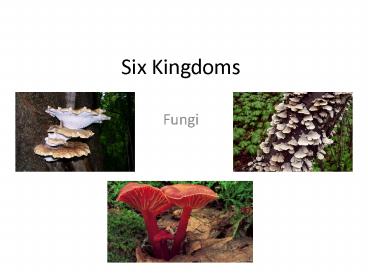Six Kingdoms - PowerPoint PPT Presentation
1 / 18
Title:
Six Kingdoms
Description:
Six Kingdoms Fungi Zombie Fungus Important Characteristics Eukaryotes (have a nucleus) Mostly multicellular (unicellular = yeasts) Use spores to reproduce ... – PowerPoint PPT presentation
Number of Views:257
Avg rating:3.0/5.0
Title: Six Kingdoms
1
Six Kingdoms
- Fungi
2
(No Transcript)
3
Zombie Fungus
4
Important Characteristics
- Eukaryotes (have a nucleus)
- Mostly multicellular (unicellular yeasts)
- Use spores to reproduce
- Heterotrophs
5
Cell Structure
- Hyphae (singular hypha) threadlike tubes
that make up the bodies of multicellular fungi. - Arrangement of hyphae
- Loosely tangled fuzzy looking mold
- Tightly packed together mushroom
6
(No Transcript)
7
How Do Fungi Obtain Food?
- The fungus grows hyphae into a food source.
- Digestive chemicals ooze from the hyphae into the
food. - Digestive chemicals break down the food so that
it can be absorbed by the hyphae. - Decomposers
- Ex mushroom
- Parasites
- Ex Athletes foot
8
Reproduction in Fungi
- Usually reproduce by spores (which are produced
by fruiting bodies) - Most fungi reproduce both asexually and sexually.
- Asexual reproduction
- When conditions are favorable, they grow fruiting
bodies release spores. - Unicellular fungi (ex yeasts) reproduce by
budding - A small cell grows from the larger parent cell
- Think of a bud on a tree
- Sexual reproduction
- Hyphae of two fungi grow together genetic
material is exchanged
9
Classification of Fungi Threadlike Fungi
This group contains about 600 different species
of molds, including many common bread molds, such
as this Rhizopus. These fungi produce spores in
their threadlike hyphae.
10
Classification of Fungi Sac Fungi
This group contains over 30,000 diverse species
of fungi, including yeast, morels, truffles, and
some fungi that cause plant diseases, such as
Dutch elm disease.
11
Classification of Fungi Club Fungi
This group includes about 25,000 species of
mushrooms, bracket fungi, plant parasites, and
puffballs. Club fungi produce spores in
structures that look like clubs. One of the
puffballs in the photo is shooting out its
spores.
12
Classification of Fungi Imperfect Fungi
The 25,000 species in this group include this
Penicillium, the source of an important
antibiotic.
13
Fungi the Living World
- Environmental recycling
- Decomposers
- Food source
- Yeast, cheese
- Cause disease
- Infect crops, athletes foot, ringworm
- Fight disease
- Penicillin
14
Fungi the Living World
- Fungus-root association
- Symbiotic relationship (mutualism)
- Ex orchids
- Lichens
- Consists of a fungus either algae or
autotrophic bacteria - pioneer organisms
15
Mushrooms
- Safe to eat can buy in a grocery store
shitake
agaricus
portobello
16
MushroomsSafe to eat can buy in a grocery
store
chanterelle
crimini
oyster
17
MushroomsSafe to eat can buy in a grocery store
porcini
enoki
morel
18
POISONOUS MUSHROOMS































